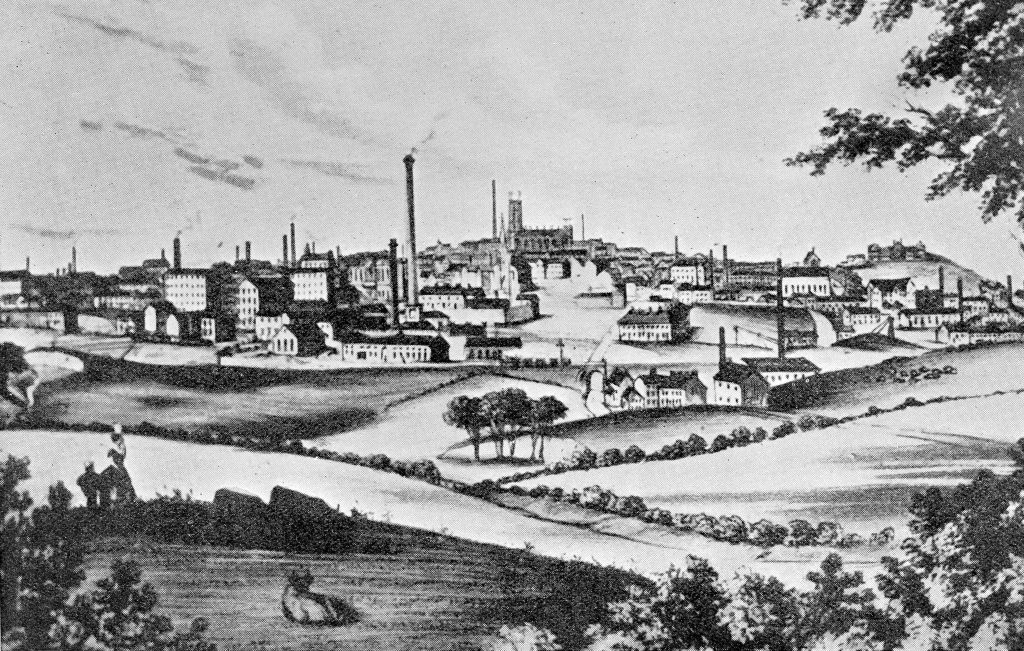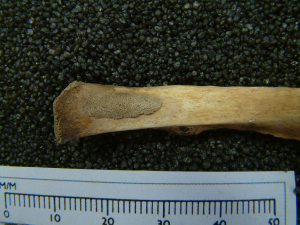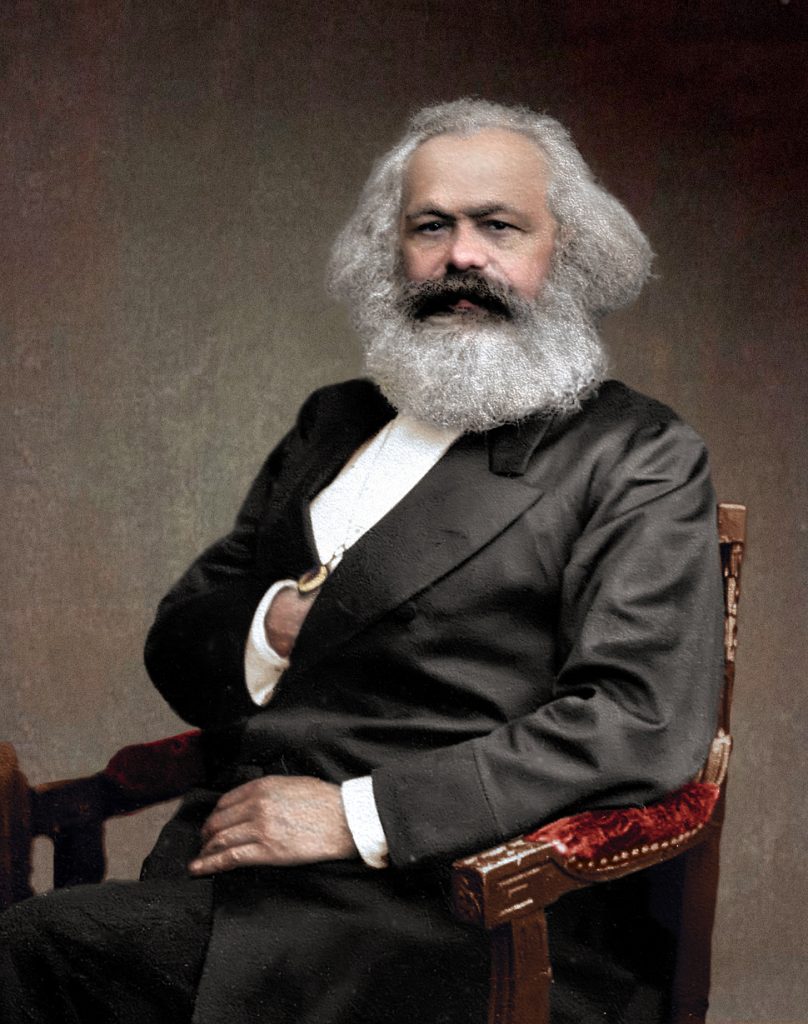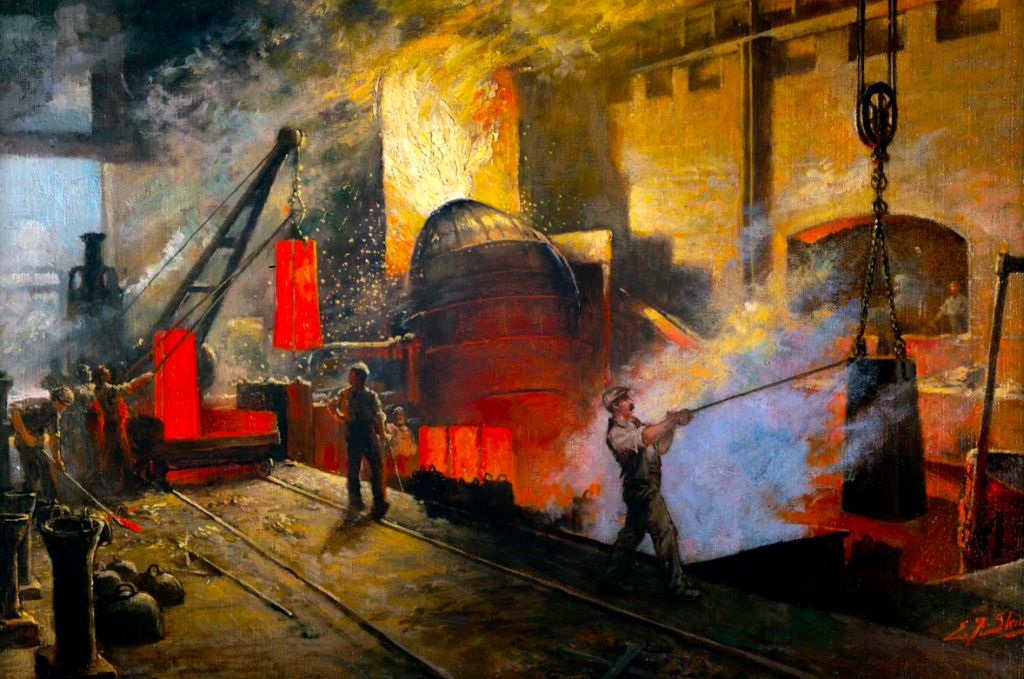2 The British Industrial Revolution 1730 until the early 20th Century
As part of the Scientific Revolution, concurrent with the ‘explosion’ of the natural sciences among the British upper class, there were also theoretical scientists such as Isaac Newton (b.1643, d. 1727) who “unified the terrestrial and celestial mechanics…and transformed the mechanical philosophy…by adding to it mathematically expressed laws” (Schuster, 1996, p. 217). These scientific ‘laws’, or perhaps the subsequent emerging scientific paradigm, fostered invention and the ‘labour-saving’ machines of the Industrial Revolution (Dennis, 2017). Machines came to ‘revolutionise’ the production of iron, steel and textiles which had a cascading effect across the British economy and society (Newton, 2021, p. 2366). The scientific method, as enacted in a culture of applied science and technology, led to the development of labour-saving machines resulting in the British Industrial Revolution (Jacob, 2014). This chapter will explore British experiences of industrialisation through until the early 20th century.
Learning Objectives
By the end of this chapter, we will have explored:
- How the Scientific Revolution enabled the British Industrial Revolution (1730 – 1850) through the creation of labour-saving machines.
- How rapid industrialisation and a population boom in Britain resulted in low wages for dangerous work and how these poor working conditions became the origins for labour (employment) relations, trade unionism and workplace health and safety.
- The emergence, in the early 20th Century, of the British Labour Party from the trade union movement.
The journey from ancient civilisations to the Scientific Revolution took thousands of years. However, the British Industrial Revolution (1730 – 1850) was a period of accelerated change and, in just over 100 years, remarkable shifts took place that impacted “demographics, politics, social structures and institutions, and the economy” (Newton, 2021, p. 2367). As Zhao explains, “in the 17th century, Britain was still a peaceful agricultural country. However, in the industrial revolution…manufacturing factories rose up along river valleys, canals and railways…[this] greatly changed the face of British towns” (Zhao, 2019, p. 107); thus the British landscape was rapidly transformed (see Figure 2.1).

Figure 2.1 Industrialisation 19th century town in Lancashire
Source: Wellcome Collection, CC BY 4.0
However, the large-scale adoption of machines during the Industrial Revolution created a different type of work. The craftsmanship developed over many generations, since the division of roles during the Neolithic Era (see Figure 1.1), was replaced by the division of labour “the extent to which jobs in an organization are subdivided into separate tasks” (Heery & Noon, 2017, para. 1). No longer would one craftsperson work from beginning to end on an item, the labour would be divided among many workers most of whom were responsible for only one task in the item’s production.
Box 2.1: English Bobbin Mill
In this video we see machines making mass production a possibility. Machines revolutionised this work as the craftsmen who would have previously handmade timber items, such as the bobbins used to hold thread during textile manufacturing, could be replaced by machines operated by less skilled labourers. This was particularly efficient given the increasing demand for bobbins during the industrial revolution’s textile industry boom.
Source: “Things to do in the Lake District: Stott Park Bobbin Mill” by English Heritage, YouTube
Influenced by Newton’s scientific laws, Scottish economist Adam Smith (b. 1723, d. 1790) sought out similar general economic principles (Montes, 2008) and observed that the division of labour “increases production and makes it more efficient by dividing the separate tasks of making an object among different individuals and thereby simplifying the job each person must perform” (Wolf, 2019, para. 3). Smith then conceptualised production’s fixed costs as raw materials, plant equipment and human capital (Spengler, 1977), where human capital was “the economic value of a worker’s experience and skills” (Kenton, 2023a, para 1). Smith perceived there to be an “unnecessary costliness of human capital as well as its suboptimal use” (Spengler, 1977, p. 25). Smith highlighted the considerable economic potential that could be harnessed from the efficient utilisation of raw materials, machines and workers. With this assertion, Adam Smith shifted both economic thought and precipitated the field of management (and subsequently HR management).
However, the rapid change of industrialisation created great challenges; the intensification of production, enabled by machines, often led to terrible conditions for the people operating the machinery. As Newton recounts:
Work places were often poorly ventilated, overcrowded, and replete with safety hazards. Men, women, and children alike were employed at subsistence wages in unhealthy and dangerous environments. Workers were often able to afford no more than the simplest housing, resulting in the rise of urban slums. Stories of the unbelievable work conditions in mines, textile factories, and other industrial plants soon became a staple of Victorian [1837 – 1901] literature. (2021, p. 2368)
Poor working conditions led to the craft guilds, who had protected crafts and trades since the Middle Ages, re-organising to raise awareness of the work conditions—this was the beginning of the trade union movement (Cartwright, 2023).
However, it is an outbreak of malignant fever at a cotton mill near Manchester in 1784 that marks the true beginnings of employment relations and workplace health and safety. Dr Thomas Percival determined that, “the epidemic was due to overwork for inordinately long hours, poor food, wretched clothing, bad ventilation, and overcrowding in insanitary houses and factories, especially by children” (Meiklejohn, 1958, p. 2). The absentee factory owner, Sir Robert Peel, was a parliamentarian who was both surprised and devastated by the conditions at his mill; he championed the Health and Morals of Apprentices Act of 1802. The legislation applied to any textile mill or factory with more than three apprentices, or over twenty workers, and required ventilation and cleaning of the workplace. Specific to apprentices was a maximum 12-hour work day, no work between 9pm and 6am, provision of work clothing and an education including reading, writing, maths and Christian religion.
Sir Robert Peel had been particularly concerned about apprentices and made them the focus of the legislation because, at the time, orphans and pauper children were often sent to live and work as apprentices at factories in compliance with the “Poor Law”, an act that ensured they were sheltered, fed and clothed. However, Sir Robert Peel disagreed with the poor conditions of the work they were exposed to in order to earn their up-keep (UK Parliament, n.d.). To contextualise this, it is important to understand that in one facility alone, that of Robert Owen’s New Lanark mill in 1799, 70% of the workforce were under 18 years old but the majority were under 13 (Bolin-Holt, 1989, as cited in Innes, 2002). On average children began working at eight and a half years old, often in cleaning roles that required them to manoeuvre around working machinery, “working for very low pay, performing work that was dirty and dangerous, and usually working long hours as well” (Griffin, 2014, para. 2).
Box 2.2: Harrowing lives of children sent to work in English mills revealed
Professor Rebecca Gowland has studied the skeletal remains of 154 people buried in a North Yorkshire cemetery, many of whom were children working in a local textile mill. Her team discovered that the children “were forced to sacrifice themselves to conditions that were detrimental to their physical and mental wellbeing, in some instances leading to death within a few years of apprenticeship” (Gowland et. al., 2023, para. 56). Figure 2.2 depicts a rib bone with abnormal bone growth. Such abnormalities on rib bones indicate lower respiratory tract disease (Davies-Barrett, Antonine & Roberts, 2019).

Figure 2.2: Abnormal bone growth on a rib indicating lower respiratory tract disease
Source: Woven bone on the visceral surface of the vertebral end of a left rib of SK 334 by Gowland et al, PLoS One, CC BY 4.0
Like to learn more? A news article on this research is available here and the original research publication is available here.
The Health and Morals of Apprentices Act of 1802 is the first piece of labour and safety legislation in the world but, unfortunately, it was poorly enforced (Innes, 2002). Preceded by the Combination Acts (1799–1800), which banned collective wage negotiations as any worker “who combined with another to gain an increase in wages or a decrease in hours” could be penalised (Encyclopaedia Britannica, 2017, para. 1), the Health and Morals of Apprentices Act of 1802 also coincided with rapid population growth. Agricultural improvements resulted in greater population health and wellbeing (Komlos, 1990), effectively providing employers with a limitless supply of willing workers (Cartwright, 2023). With no tangible legal consequences for employers, and an inhibition of worker collectives, there was little actual possibility for improved labour and safety outcomes for workers at this time.
Over the following decades, political tolerance for non-compliance by factory owners waned as members of Britain’s parliament, some of whom were also factory owners themselves, took a paternalistic view towards their workers. The Health and Morals of Apprentices Act of 1802 signalled an important shift in labour health and safety management with the introduction of factory inspectors who could enforce infringement notices, however, there were too few inspectors to enforce the Act with just four inspectors being responsible for 4000 mills (UK Parliament, n.d.). Political efforts continued with Lord Ashley-Cooper campaigning for the Mines Act of 1842, which banned all women and girls from mining and excluding boys under 10 years of age, and again he championed the Ten Hours Act of 1847 which sought to reduce the workday in mills to ten hours (Encyclopaedia Britannica, 2023c).
In the emerging industrialised environment, legally it was becoming challenging for workers and employers to effectively negotiate wages without being at risk of contravening the Combination Acts. In 1859, Judge Rupert Kettle began advocating for legal mechanisms, such as arbitration, to resolve industrial disputes with a view that laws should “be used to foster negotiation between masters and men, not to quash collective action by either side” (Cornish, 2010, p. 668). The 1868 Royal Commission into Organisation and Rules of Trades Unions and Other Associations followed. It produced a majority report supporting the status quo of unions as illegal while a minority report favoured the regulation of trade unions, the latter came to be adopted by government (Cornish, 2010). This led to the Trade Union Act 1871 which decriminalised the formal association of workers for wage bargaining, however striking was still illegal (Cornish, 2010).
It is important to recognise that these times and events are both shaped by, and influence, societal and government debate. Why, for example, would the government of the day choose to support the minority rather than the majority report? Historical figures, such as Karl Marx who was based in London during these times, were shaping intellectual debate on capitalism, communism, and human labour. Such societal debates would naturally influence political leaders. Box 2.3 provides a very brief overview of Karl Marx’s perspective on labour.
Box 2.3: Karl Marx (b. 1818, d. 1883)

Figure 2.3: Karl Marx (circa 1875)
Source: “Karl Marx 1875” by John Jabez Edwin Mayall colored by Olga Shirnina, Wikimedia Commons, Public Domain
In 1867, while based in London, Karl Marx published Das Capital. In critiquing Adam Smith’s conceptualisation of production as being solely a capitalist approach, Marx focused specifically on the labour component. He proposed that “there are two major flaws inherent in capitalism that lead to the exploitation of workers by employers: the chaotic nature of free market competition and the extraction of surplus labour” (Kenton, 2023, para. 9). Marx argues that profit is achieved when employers pay staff less than the value of their labour, not by selling items at a higher price (Liberto, 2021). This conceptualisation of the relationship between labour exploitation and employer profit likely shaped the subsequent government decision to establish the Trade Union Act 1871 to counteract the imbalance of power between employers and workers.
In concluding our understanding of the impact of the British Industrial Revolution on labour (employment) relations, unions and safety, it would be remiss not to mention the Fabian Society. The Fabian Society was established in January of 1884 to achieve socialist objectives in a slow and methodical manner, as opposed to revolutionary, manner and this non-violent approach to change arguably enabled their positive engagement with government (Fabian Society, n.d.). In 1900, the Fabian Society became a founding member of the British Labour Party (The Labour Party, n.d.) and in the 1906 elections there were 26 voted representatives who considered themselves to be for ‘labour’. In 1906, the Fabians, together with the ‘labour’ representatives, had successfully lobbied to establish a minimum wage and by 1911, they had established foundations for the British universal healthcare system (Fabian Society, n.d.).
Crucial founders and actors in the Fabian Society were Beatrice and Sidney Webb who wrote many of the Society’s foundational publications, including the History of Trade Unionism in 1894. While their contributions in this arena are many, they are renown for having coined the term ‘collective bargaining’, in the aforementioned publication (Webb & Webb, 1898, p. 33). At the end of the 19th century “free bargaining between the capitalist and his workmen became the sole method of fixing wages” (Webb & Webb, 1898, p. 77), disadvantaging the workers and creating the aforementioned legal quandaries (Cornish, 2010). The Webbs’ acknowledged that it was approximately 50 years before the Act of 1825 provided the “right of collective bargaining, involving the power to withhold labour from the market by concerted action” in Britain (Webb & Webb, 1898, p. 111).
The British Industrial Revolution, at its conclusion, had led to massification of production, with the assistance of ‘labour-saving’ machinery (see Figure 2.4). Its beginnings saw the most vulnerable of workers labouring in the harshest of conditions. We also saw initial efforts from paternalistic owners, some of whom were in parliament, to reduce child labour and increase regulation around the hours of workers. A demographic population ‘boom’, and the associated availability of labour, made achieving better working conditions, and particularly better wages, particularly difficult throughout this period. Come the turn of the 20th century, however, efforts were underway to enable the collective association of workers, underpinning the formation of the British Labour Party which would, over time, led to the modern British trade union movement.

Figure 2.4: Making Bessemer Steel, Edward Frederick Skinner oil painting (1917)
Source: “Making Steel by Skinner,” Science Museum London, CC BY-NC-SA 4.0
While the Industrial Revolution began in Britain, it was not geographically constrained and it moved rapidly across Europe. Moreover, it reached the Americas via Britain’s colony as approximately 6000 people emigrated from Britain between 1773 and 1776, and “with these immigrants came some textile workers who were familiar with the latest innovations in spinning wool and cotton” (Weightman, 2007, p. 37). Chapter 3 pivots from this examination of the British context, to consider the impact of industrialisation on the United States (sometimes known as the Second Industrial Revolution) and the uniquely American phenomena that have implications for workplace health and safety today.
"Mathematical and experimental technique employed in the sciences. More specifically, it is the technique used in the construction and testing of a scientific hypothesis" (Encyclopaedia Britannica, 2023, para. 1, Scientific Method).
Work is "the activities and labour necessary to the survival of society" (Encylopaedia Britannica, 2018, para. 1).
“Human capital, intangible, collective resources possessed by individuals and groups within a given population These resources include all the knowledge, talents, skills, abilities, experience, intelligence, training, judgment, and wisdom possessed individually and collectively, the cumulative total of which represents a form of wealth available to nations and organizations to accomplish their goals” (Huff, n.d., para. 1).
“Organization, supervision, or direction; the application of skill or care in the manipulation, use, treatment, or control (of a thing or person), or in the conduct of something” Oxford English Dictionary, n.d., para. 1).
“The management of people in working organizations. It is also frequently called personnel management” Encyclopedia Britannica, 2023, para.1).
“The development of industries in a country or region on a wide scale; the process of industrializing or fact of being industrialized” (Oxford English Dictionary, n.d., p.1).
“Middle Ages, the period in European history from the collapse of the Roman civilisation in the 5th century to the period of Renaissance (variously interpreted as beginning in the 13th, 14th or 15th century, depending on the region of Europe and other factors)” (Encyclopaedia Britannica 2023, para 1).
“Trade union, also called labour union [particularly in the United States], association of workers in a particular trade, industry or company created for the purposes of securing improvements in pay, benefits, working conditions or social and political status through collective bargaining” (Encyclopedia Britannica, n.d., para. 1). Notably, Trade unions emerged in the United Kingdom during the Industrial Revolution to protect craftsperson's rights (they emerged from original crafts guilds), whereas in the United States they drew all workers (skilled and unskilled) together to negotiate labour rights (hence these are known as Labour Unions).
“Of, relating to, or of the nature of paternalism; practising paternalism” (Oxford English Dictionary, n.d., para. 1).
“The practices or principles of capitalists; the dominance of capitalists in financial and business enterprises; an economic system based on wage labour in which the means of production is controlled by private or corporate interests for the purpose of profit, with prices determined largely by competition in a free market” (Oxford English Dictionary, n.d., para 1).
"A theory that advocates the abolition of private ownership, all property being vested in the community, and the organization of labour for the common benefit of all members; a system of social organization in which this theory is put into practice" (Oxford English Dictionary, n.d., para.1).
Labour "means any valuable service rendered by a human agent in the production of wealth, other than accumulating and providing capital or assuming the risks that are a normal part of business undertakings" (Encyclopedia Britannica, 2022, para. 1).
"A theory or system of social organization based on state or collective ownership and regulation of the means of production, distribution, and exchange for the common benefit of all members of society; advocacy or practice of such a system, especially as a political movement" (Oxford English Dictionary, n.d.).
“Collective Bargaining, the ongoing process of negotiation between representatives of workers and emloyers to establish the conditions of employment” Encyclopedia Britannica, 18th September 2023.

